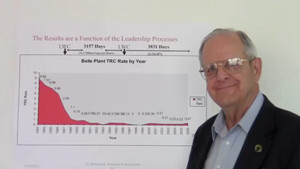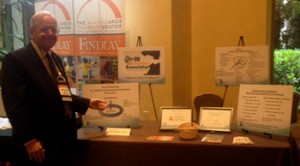The Four Simple Steps to Safety Excellence
- Get clear, focused, and determined.
Co-create the Safety Strategic Plan© using the Process Enneagram©. Keep it posted, talked about, and used. - Build trust and interdependence.
Develop the shared, co-created Principles and Standards of behavior that are needed to achieve safety excellence. Live by them in doing the work on the Issues that need to be addressed to improve safety performance. Hold each other accountable. Let everyone know you deeply care about safety and everyone going home healthy and in one piece. Make this work open and visible for everyone to see and to model in his or her own work. Trust and interdependence emerge as people learn to work together this way. - Talk with everyone, share information openly, and listen to each other.
Walk around, talking and listening, every day. As people get to know you better and see you being honest and keeping your word, trying to improve yourself and admitting to mistakes when they are made, trust builds.
(Since over 95% of all injuries and incidents are the result of the actions of people, go look at what people are doing. Do Safe Acts Auditing to see and keep track of how people are working. Show the people you really care about improving safety.
These audits give a quick indication of what is happening in the safety culture, providing clues to changes; a drop in the Safe Acts Index (SAI) indicates a potential injury is about to happen. The patterns of behaviors that are seen indicate areas of strength and areas of weakness that need to be addressed. Perhaps there are bad habits or more training is needed, or there is a confusing mixed message or a deeper systems problem needs to be straightened out. When people see and become aware of what is happening, focused attention can be applied.)
- Quickly take the appropriate actions on new information that is created to correct the problems that the patterns of unsafe behaviors observed indicate. Remember that the information developed in these Audits is for learning about how to improve the safety performance. If this Safe Acts Auditing tool is used for punishment, the integrity and value of this process is lost.
Evolve steps 1, 2, 3 and 4 all at the same time as the Safety Leadership Process™ develops. They are all interconnected and interacting all the time. Do them over and over again.- It takes the courage to hold each other accountable, to have the difficult conversations, to make decisions, and to act.
- It requires the care to do every thing as well as you can.
- It requires the concern for the impacts for all the changes on all the stakeholders.
- It requires the commitment to stay the course in both the good and difficult times, day after day, month after month, year after year!
- This is the essence of safety leadership.

 The first part of this work is sharing all information and talking together about it. Another part is building trust and interdependence with the people as we openly discuss what is happening, what we are doing and why. The third part of this work is helping people to see the big picture and how important their part is to the success of the whole business.
The first part of this work is sharing all information and talking together about it. Another part is building trust and interdependence with the people as we openly discuss what is happening, what we are doing and why. The third part of this work is helping people to see the big picture and how important their part is to the success of the whole business. Lots of critical knowledge, experience and skills will be lost. Younger people, who have grown up in an electronic world of texting and games, will replace these people. Many are out of shape and bordering on being over weight; some are developing diabetes. This will pose significant challenges to employers and the need to work safely and well.
Lots of critical knowledge, experience and skills will be lost. Younger people, who have grown up in an electronic world of texting and games, will replace these people. Many are out of shape and bordering on being over weight; some are developing diabetes. This will pose significant challenges to employers and the need to work safely and well. Most of the safety people I’ve come to know approach organizations as if they are mechanical things to manipulate. Organizations are structured in functions. Knowledge is structured in pieces. People are narrowly skilled. Motivation is based on external factors. Information is shared on a need to know basis. Change is a troubling problem. People work in prescribed roles seeing only their part of the work. If change is needed people are moved around like chairs. Training is provided in abundance. Safety programs are set up as step-by-step processes where things are arranged in a prescribed sequence.
Most of the safety people I’ve come to know approach organizations as if they are mechanical things to manipulate. Organizations are structured in functions. Knowledge is structured in pieces. People are narrowly skilled. Motivation is based on external factors. Information is shared on a need to know basis. Change is a troubling problem. People work in prescribed roles seeing only their part of the work. If change is needed people are moved around like chairs. Training is provided in abundance. Safety programs are set up as step-by-step processes where things are arranged in a prescribed sequence.  When I began to learn about chaos and complexity science, I saw that this was the way to handle the high level of change. As we shared more and more information, helped people to really understand the nature of the business and their important roles in its success, and as we built more trust and interdependence, people began to step forward to help us take on all the changes that poured into our organization. I did not have to do everything myself, which was a great relief.
When I began to learn about chaos and complexity science, I saw that this was the way to handle the high level of change. As we shared more and more information, helped people to really understand the nature of the business and their important roles in its success, and as we built more trust and interdependence, people began to step forward to help us take on all the changes that poured into our organization. I did not have to do everything myself, which was a great relief. It was fascinating to see the contrast between the usual, linear, mechanical approach to safety and The Complexity Leadership Process (CLP) that I discussed at my display table. A large number of people talked with me at my display table about The Complexity Leadership Process which was new to all of them. Many could not believe how quickly and dramatically the safety performance improved using the CLP. At one level the CLP looks like a simple employee involvement program, yet it is much more and also different at a deeper level than the usual employee involvement processes. One fellow, who recently wrote a book about changing the safety culture to excellence just brushed the CLP aside as something he’d already seen. The approach to safety excellence he’s written about involves 43 linear steps that take 3-5 times as long as the CLP and require a very high level of persistence and determination over many years.
It was fascinating to see the contrast between the usual, linear, mechanical approach to safety and The Complexity Leadership Process (CLP) that I discussed at my display table. A large number of people talked with me at my display table about The Complexity Leadership Process which was new to all of them. Many could not believe how quickly and dramatically the safety performance improved using the CLP. At one level the CLP looks like a simple employee involvement program, yet it is much more and also different at a deeper level than the usual employee involvement processes. One fellow, who recently wrote a book about changing the safety culture to excellence just brushed the CLP aside as something he’d already seen. The approach to safety excellence he’s written about involves 43 linear steps that take 3-5 times as long as the CLP and require a very high level of persistence and determination over many years. I’ll be participating as a sponsor for the Conference Program Brochure. I’ll have an ad in the Brochure as well as a display table. My tag line is “When safety gets right, everything else gets right”. Since I am not an official speaker, I am going to use my display table as an opportunity to talk with people about the
I’ll be participating as a sponsor for the Conference Program Brochure. I’ll have an ad in the Brochure as well as a display table. My tag line is “When safety gets right, everything else gets right”. Since I am not an official speaker, I am going to use my display table as an opportunity to talk with people about the  This Blog is focused on my new book, The Process Enneagram©: Essays on Theory and Practice. I am the editor for this book that was just published by Emergent Publications. It can be purchased directly from their
This Blog is focused on my new book, The Process Enneagram©: Essays on Theory and Practice. I am the editor for this book that was just published by Emergent Publications. It can be purchased directly from their  Overlap: All three of these areas of safety are often lumped together as SHE, EHS or HSE. When we lump these all together we can miss things so I think it is useful to see these three overlapping, interacting areas of our safety and health work. There is some overlap between Occupational Safety and Occupational Health like the proper selection and use of respirators. There is some area of overlap between Occupational Health and Process Safety like preventing chronic exposures to toxic chemicals. There is some overlap between Process Safety and Occupational Safety like locating trailers and offices away from operating areas using large quantities of flammable and explosive materials.
Overlap: All three of these areas of safety are often lumped together as SHE, EHS or HSE. When we lump these all together we can miss things so I think it is useful to see these three overlapping, interacting areas of our safety and health work. There is some overlap between Occupational Safety and Occupational Health like the proper selection and use of respirators. There is some area of overlap between Occupational Health and Process Safety like preventing chronic exposures to toxic chemicals. There is some overlap between Process Safety and Occupational Safety like locating trailers and offices away from operating areas using large quantities of flammable and explosive materials.




